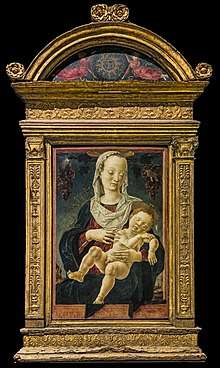Cosimo Tura
| Cosimo Tura | |
|---|---|
 An Allegorical Figure of Calliope, c. 1460 | |
| Born |
c. 1430 Ferrara |
| Died |
c. 1495 Ferrara |
| Nationality | Italian |
| Known for | Painting |
| Movement | Quattrocento or early-Renaissance |
Cosimo Tura (c. 1430 – 1495), also known as Il Cosmè or Cosmè Tura (Italian pronunciation: [koˈzmɛ ˈtuːra]), was an Italian early-Renaissance (or Quattrocento) painter and considered one of the founders of the School of Ferrara.
Born in Ferrara, he was a student of Francesco Squarcione of Padua. Later he obtained patronage from both Dukes Borso and Ercole I d'Este. By 1460, he was given a stipend by the Ferrarese Court. His pupils include Francesco del Cossa and Francesco Bianchi. He appears to have been influenced by Mantegna's and Piero della Francesca's Quattrocento styles.
In Ferrara, he is well represented by frescoes in the Palazzo Schifanoia (1469–71).[1] This pleasure palace, with facade and architecture of little note, belonged to the d'Este family and is located just outside the medieval town walls. Cosimo, along with Francesco del Cossa, helped produce an intricately conceived allegorical series about the months of the year and zodiac symbols. The series contains contemporary portraits of musicians, laborers, and carnival floats in idyllic parades. As in Piero della Francesca's world, the unemotive figures mill in classical serenity.
He also painted the organ doors for the Duomo showing the Annunciation (1469). He collaborated in the painting of a series of "muses" for a Studiolo of the Palace Belfiore of Leonello d'Este in Ferrara, including the allegorical figure of Calliope at the National Gallery (see image). While the individual attributions are often debated, among the artists thought to complete the series were Angelo di Pietro da Sienna, also called Maccagnino or Angelo Parrasio, and Michele Pannonio.
Selected works

- Saint George - San Diego Museum of Art[2]
- Pieta (c. 1460) - Museo Correr, Venice[3]
- Judgment and Martyrdom of Saint Maurelius (1470s) - Pinacoteca Nazionale, Ferrara[4]
- The Circumcision of Christ (1470s) - Isabella Stewart Gardner Museum, Boston[5]
- Madonna and Child (1455) - National Gallery of Art, Washington D.C.[6]
- Portrait Eleonora d'Aragona, Duchess of Ferrara - Pierpont Morgan Library, New York[7]
- Spring or the muse "Calliope" (1460) - National Gallery, London.[8]
- The Princess (1470) - Museo del Duomo, Ferrara.[9]
- St. George and the Dragon (1469) - Museo del Duomo, Ferrara[10]
- Madonna Enthroned (1474) - National Gallery, London[11]
- St. Sebastian - Gemäldegalerie, Dresden, Germany[12]
- St. Dominic - Uffizi, Florence[13]
- Pietà, (Louvre)[14]
- St. Anthony of Padua Reading - Louvre, Paris[15]
- Pietà (c. 1472) - Museo Correr, Venice
- Lamentation (c. 1472) - Roverella altarpiece
- Saint Nicholas - Musée des Beaux-Arts de Nantes
- Letter A miniature from choirbook (Metropolitan Museum, New York)[16]
- Frescoes at the Palazzo Schifanoia, Ferrara[17]
- Allegory of September: Triumph of Vulcan
- Allegory of August: Triumph of Ceres
- Allegory of June: Triumph of Mercury
References
- ↑ Este Court Archives Archived 2014-12-09 at the Wayback Machine., project entry on Palace Schifanoia.
- ↑ Archived April 11, 2005, at the Wayback Machine.
- ↑ Archived April 11, 2005, at the Wayback Machine.
- ↑ Archived April 11, 2005, at the Wayback Machine.
- ↑ Circumcision Gardner Museum.
- ↑ Archived April 11, 2005, at the Wayback Machine.
- ↑ Archived April 11, 2005, at the Wayback Machine.
- ↑ "Cosme Tura. Spring - Olga's Gallery". Abcgallery.com. Retrieved 7 October 2014.
- ↑ "Cosme Tura. The Princess - Olga's Gallery". Abcgallery.com. Retrieved 7 October 2014.
- ↑ "Cosme Tura. St. George and the Dragon - Olga's Gallery". Abcgallery.com. Retrieved 7 October 2014.
- ↑ "Cosme Tura. Madonna Enthroned - Olga's Gallery". Abcgallery.com. Retrieved 7 October 2014.
- ↑ "Cosme Tura. St. Sebastian - Olga's Gallery". Abcgallery.com. Retrieved 7 October 2014.
- ↑ "Cosme Tura. St. Dominic - Olga's Gallery". Abcgallery.com. Retrieved 7 October 2014.
- ↑ "Cosme Tura. Pietà - Olga's Gallery". Abcgallery.com. Retrieved 7 October 2014.
- ↑ "Cosme Tura. St. Anthony of Padua Reading - Olga's Gallery". Abcgallery.com. Retrieved 7 October 2014.
- ↑ Archived September 30, 2007, at the Wayback Machine.
- ↑ "Web Gallery of Art, image collection, virtual museum, searchable database of European fine arts (1000-1900)". Wga.hu. Retrieved 7 October 2014.
Bibliography
- Haldane Macfall, History of Painting: The Renaissance in Venice Part Two, page 34, ISBN 1-4179-4507-9
External links
- trionfi.com
- Mann, C. Griffith (1998). "Cosme Tura of Ferrara: Style, Politics, and the Renaissance City, 1450-1495". MLN. 113 (5): 1209. doi:10.1353/mln.1998.0067.
- Cosme Tura at Panopticon Virtual Art Gallery
- Italian Paintings: North Italian School, a collection catalog containing information about Tura and his works (see pages: 61-67).
| Wikimedia Commons has media related to Cosmè Tura. |